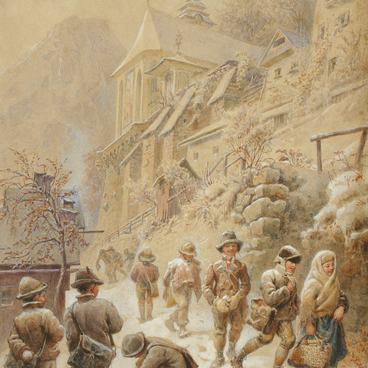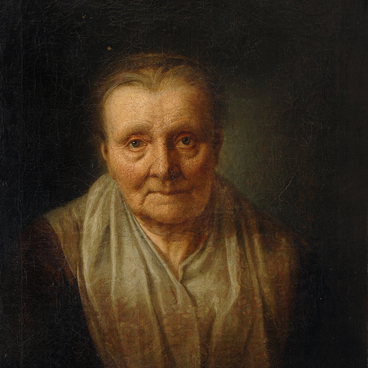Until 1930, the painting “The Visitation” was in the collection of the Pushkin State Museum of Fine Arts, where it came from the broken up private collection of the patron of arts and perfumer Henri Brocard, the founder of the “Novaya Zarya” company. Henri Brocard had a huge museum in Moscow in the Upper Trading Rows (now GUM). The centerpiece of his collection was a gallery of Western European painting of the 15th–18th centuries. In the 1920s, the museum was closed: the pictures of Russian artists were transferred to the Tretyakov Gallery; paintings and graphics of Western European masters — to the Museum of Fine Arts; icons, embroidery, bronzes, tapestries, furniture — to the State Museum Fund.
The subject of the painting “The Visitation” by an unknown artist of the Italian school is dedicated to an event described in the Gospel of Luke: the visit of Mary to Elizabeth, the mother of John the Baptist.
According to the Gospel, the Archangel Gabriel brought the Virgin the good news of the future birth of her son, Jesus Christ. Asking the archangel, Mary learned that her cousin Elizabeth was also expecting a child. The news was especially joyful, since Elizabeth and her husband Zechariah, who was not young anymore, were childless. Mary traveled to the city of Judah, hurrying to tell her sister the news. According to St. Luke, the moment Mary greeted her, Elizabeth felt the baby move and called Mary “the mother of the Lord” for the first time.
St. Luke’s description of the meeting between Mary and Elizabeth is brief, but the subject has become one of the most common in European painting. It was embodied in sculpture, painting, and iconography by both Catholic and Orthodox artists.
The artist painted “The Visitation” in the 16th century when the Renaissance was nearing its end. At the time, painters already used oil paint, which, unlike tempera, allowed to achieve greater color saturation and create nuanced light-to-dark transitions.
Behind Elizabeth, there is a portal resembling the entrance to an ancient temple — the combination of biblical subjects with the heritage of ancient Greek and Roman art, characteristic of the Renaissance.
Like Jesus Christ, John the Baptist was to be martyred. However, there is no place for tragedy in the painting — the composition is full of Renaissance optimism, greatness of human spirit, beauty, and harmony.
The subject of the painting “The Visitation” by an unknown artist of the Italian school is dedicated to an event described in the Gospel of Luke: the visit of Mary to Elizabeth, the mother of John the Baptist.
According to the Gospel, the Archangel Gabriel brought the Virgin the good news of the future birth of her son, Jesus Christ. Asking the archangel, Mary learned that her cousin Elizabeth was also expecting a child. The news was especially joyful, since Elizabeth and her husband Zechariah, who was not young anymore, were childless. Mary traveled to the city of Judah, hurrying to tell her sister the news. According to St. Luke, the moment Mary greeted her, Elizabeth felt the baby move and called Mary “the mother of the Lord” for the first time.
St. Luke’s description of the meeting between Mary and Elizabeth is brief, but the subject has become one of the most common in European painting. It was embodied in sculpture, painting, and iconography by both Catholic and Orthodox artists.
The artist painted “The Visitation” in the 16th century when the Renaissance was nearing its end. At the time, painters already used oil paint, which, unlike tempera, allowed to achieve greater color saturation and create nuanced light-to-dark transitions.
Behind Elizabeth, there is a portal resembling the entrance to an ancient temple — the combination of biblical subjects with the heritage of ancient Greek and Roman art, characteristic of the Renaissance.
Like Jesus Christ, John the Baptist was to be martyred. However, there is no place for tragedy in the painting — the composition is full of Renaissance optimism, greatness of human spirit, beauty, and harmony.



